The Okinawan islands are an archipelago off the southernmost tip of Japan characterized by their double-colonization: first by the Japanese in the nineteenth century, and later by the United States after the Second World War. Between 1945 and 1972, Okinawa was occupied by the United States, where it began expanding its military presence in the Pacific. Under the 1971 Okinawan Reversion Agreement, the United States retained its right to control its bases despite Japan’s jurisdiction over the territory. Although the Okinawan archipelago composes only 0.6 percent of Japanese territory, it is host to 73.8 percent of the US military infrastructure in Japan. American military bases have dominated Okinawan politics since the occupation period and continue to leave a profound social, ecological, and spatial footprint on the island.
The impacts of US occupation are well documented, but perhaps most poignantly so by Mao Ishikawa. In 1975, the Japanese photographer set out to document the American presence on the island. Unable to visit military bases, Ishikawa began working at a bar in Koza City that catered to Black soldiers.1 Discrimination within military ranks created segregated social spaces on the island, and the bars in Koza City became bunkers for taboo relationships between Okinawan women and Black Americans. The photographer describes Okinawa as a “no man’s land,” caught between its Indigenous (Ryūkyūan) roots, the Japanese government, and the United States. With Red Flower (New York: Session Press, 2011), Ishikawa sought to destabilize a narrative she encountered on the island that women who were in relationships with American soldiers were sex workers or traitors to their own people. Instead, she tells a love story against a backdrop of imperial actors. The opening text of Red Flower reads, “What’s wrong with loving a black man! What’s wrong with working at a black bar! What’s wrong with celebrating our freedom! What’s wrong with enjoying sex!”2
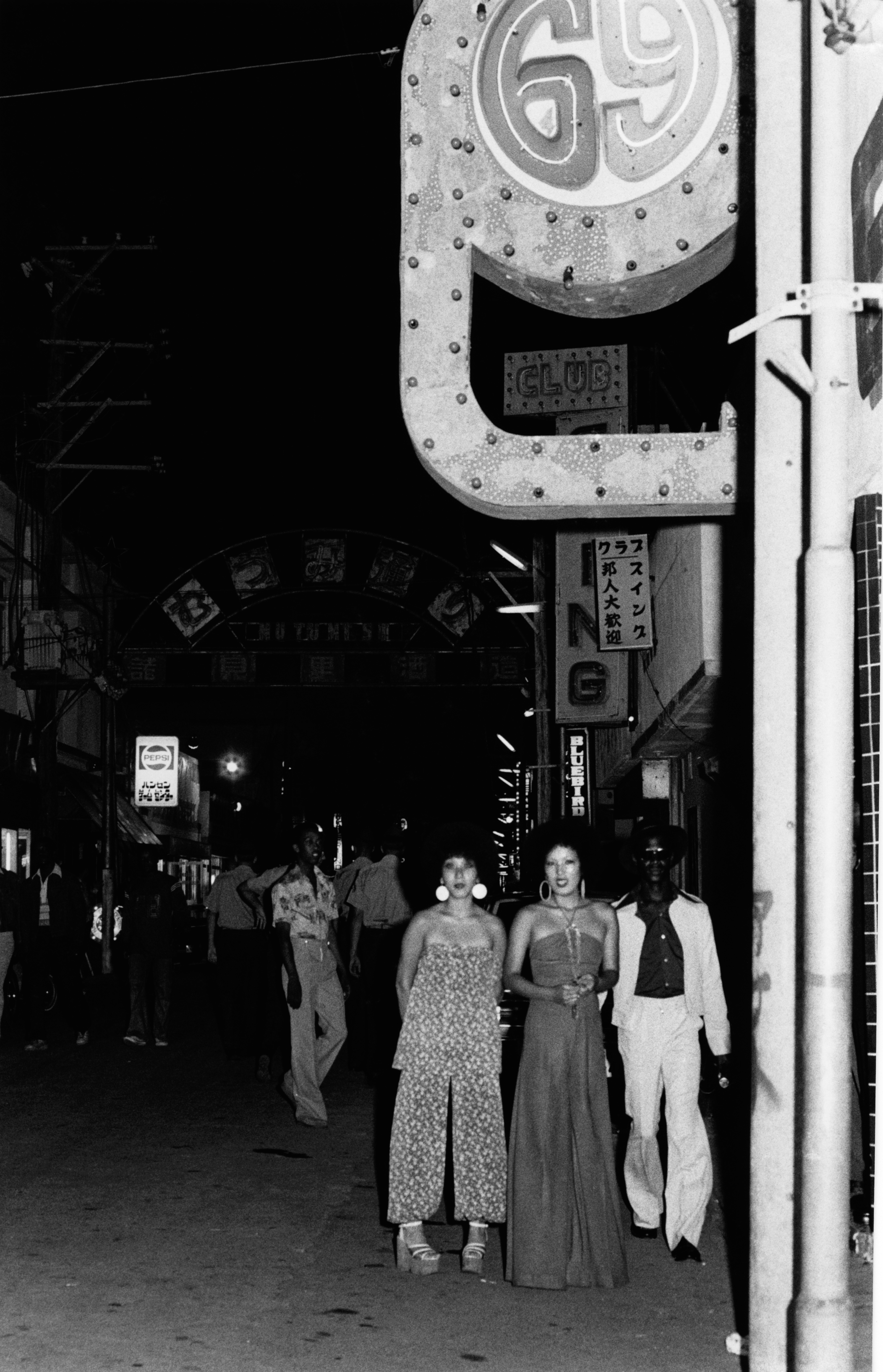
In the book, Ishikawa hones in on intimate spaces at the intersection of Japanese and American control: bars, domestic spaces, and, occasionally, the beach. An image appears early on of three friends—one man and two women—standing in front of a bar in Koza City. The camera’s flash illuminates the women’s large earrings and the man’s white suit. To their right, a large neon sign marks the entrance to a nightclub. This is one of the few images in Red Flower taken in a public space. Accordingly, the exterior of the building serves as one of the few representations of the island’s architecture. Although Red Flower hardly takes its viewers outside of its intimate interiors, the book is deeply informed by the built and natural environments surrounding its subjects. As with the women at the book’s center, treating the island in this way similarly presents a challenging counter-reality to dominant narratives surrounding the nature of American military presence in Okinawa.
Okinawan beaches are known to be exceptional. Photographs of beautiful blue waters, dazzling white sands, and lush forests have long made Okinawa a desirable tourist destination. However, this dreaminess is distorted in Western culture. As the cultural geographer Sasha Davis writes, “‘The Beach’ has been constructed as a zone outside normal social conventions. It is a zone designated for play, for eroticism, and for gazing upon both landscapes and bodies.”3 For the West, the image of the pristine beach constructed by tourist ephemera like postcards and travel websites enables performances and behaviors that would be unacceptable on the mainland. Understood in Davis’s terms, the Beach is presented to tourists as a place of hedonistic exceptionalism.
Situated between Japan and Taiwan, Okinawa is a strategic military foothold. For the United States, the “discovery” and acquisition of Californian territory didn’t signal the end of expansion. “Manifest Destiny,” the nineteenth century doctrine that the US had a divine right to colonial expansion beyond its frontier, undergirded contemporary American (Imperial) Exceptionalism. The new frontier began at the Pacific coast of the United States. At the time of the United States’ occupation of Japan in 1945, advanced cartographic tools and aerial photographs were becoming the foundation for a detached, strategic, military survey of the landscape that enabled exceptional behaviors. The offshoring of ecological damage and a culture of disposability turned Okinawa into a beach for military routines where Okinawans were perceived as abstract entities in the eyes of the military. American military presence became the dominant spatial force on the island with compounds and suburbs carving out vast swaths of the verdant island.
Since Okinawa is foreign soil, there is little incentive for the American military to protect the island beyond the bounds of its occupation. Instead, it is valued by the imperial power only as a strategic site for operations and ideologies. For Sasha Davis, this is the key distinction between “Seeing like a State” and “Seeing like an Empire.”4 The beach is a zone outside of the social and ecological standards of care that exist regarding the protection of wilderness on domestic soil. It is evident that narratives of place have spatial outcomes. They can be traced along the edges of military compounds or beach resorts. In Okinawa, the convergence of narratives of the landscape packaged for tourists and American exceptionalism enables violence against the Okinawan people and landscapes of impunity for American military personnel who benefit from extraterritorial rights and protections. The island is treated as a wasteland.
However, the architectural footprint of Red Flower is harder to locate. Even when at a bar, it is never really clear whether you are in an interior or exterior space with the subjects of the photograph. The compositions only offer spatial hints through Coca-Cola signs or the entrance to a bathroom. Viewers are witnesses to ephemeral, informal spaces of gathering and celebration. In bedrooms, there is often an intricate mixture of bodies and sheets, with light flowing in through half-shuttered windows. The tightness of the compositions, their attention to expressions, eroticism, and the human body, turn the unexceptional spaces they inhabit into places of intense intimacy. The images exhibit a precarious and vulnerable quality that defines their settings as well as the ways that the sitters of the photographs behave within them. However small or unmonumental the spaces inhabited by Mao Ishikawa and her friends might be, they represent zones that transcend racial, national, military, and domestic borders.
After being introduced to the women of Okinawa and the domestic spaces they inhabit, Ishikawa takes the viewer to the beach. Here, the beach remains an environment for pleasure and leisure—but nonetheless provides an alternative to tourist imagery. Instead, the portrait of Mao’s friend standing next to a stereo depicts the beach as another site of shared intimacy.
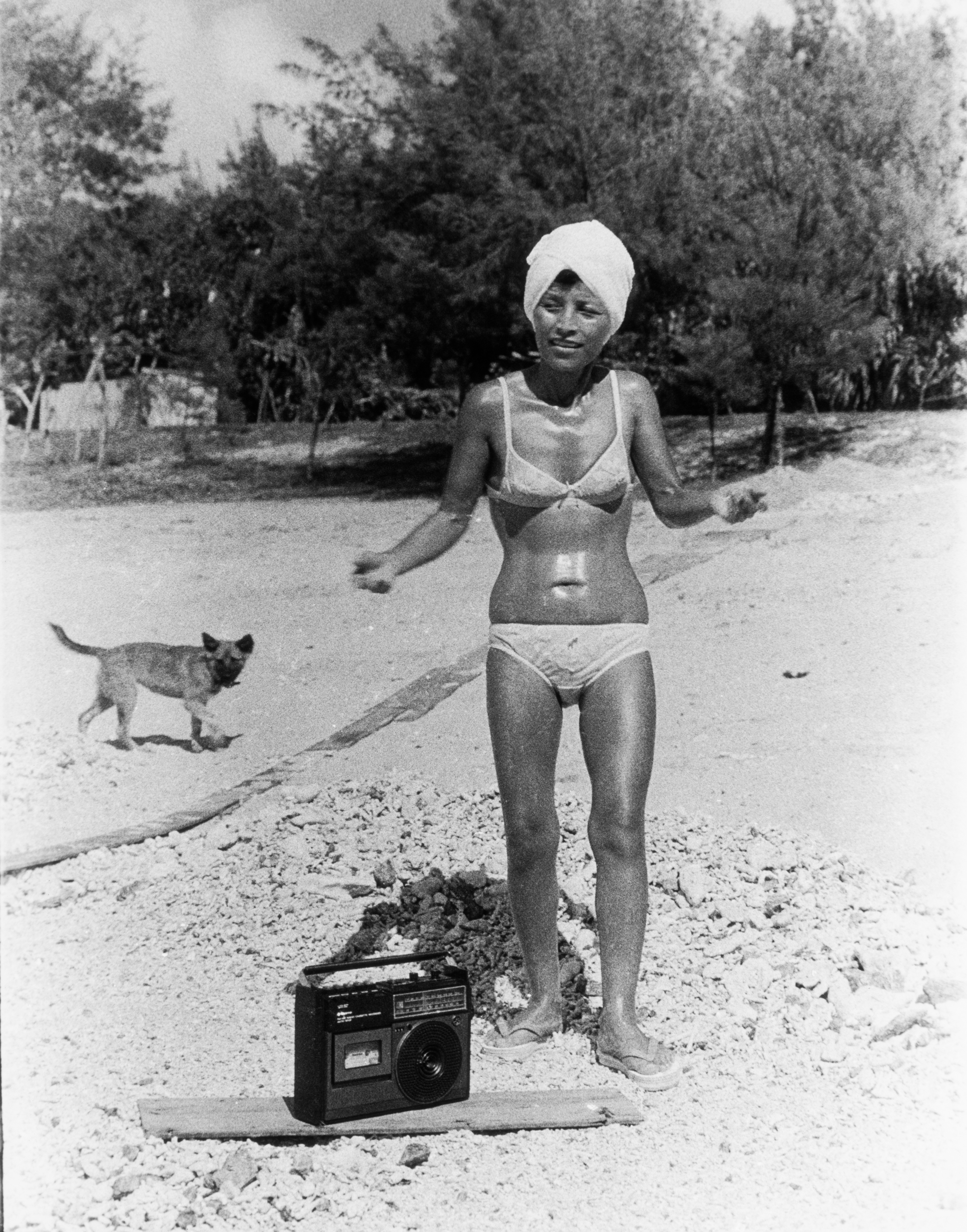
Red Flower is highly controversial in the context of Okinawa’s history. Although Ishikawa’s photographs were taken between 1975 and 1977, Red Flower was published amid the ongoing ecological crisis caused by the relocation of Marine Corps Air Station Futenma from Ginowan to Henoko-Oura Bay—a crisis that has dominated contemporary Okinawan politics.5 The book was also published after various lawsuits against the United States Military, the most high profile of which was a sexual assault case from 1995 that transformed US–Japan relations.
On September 4, 1995, a twelve-year-old girl was abducted, beaten, and raped by three US servicemen. The girl—left for dead on an isolated area near Kin village—was able to get herself to a road where she found help and reported the assault. The men were apprehended on September 6, and Okinawan news outlets quickly began covering the incident.6 Its brutality prompted immediate outrage at local, national, and international levels. Although the men were apprehended, the US–Japan Status of Forces agreement delayed the Okinawan prefectural government’s ability to file charges.7 Ultimately the men pled guilty and served five years in Japanese prisons before returning to the United States, without being registered as sex offenders following the terms of American occupation.8
Public outcry was quickly mobilized by local leaders, calling attention to the shortcomings of US–Japan security agreements—particularly, in this case, their standing in the way of the proper prosecution of US servicemen for crimes on foreign soil. Although this was not the first (nor last) violent crime against Okinawan people, the feminist scholar Linda Angst writes:
A crisis of sovereignty replaced the crisis for women and a particular girl, which gradually faded from view, as did the agenda of feminist activists… the rape has been enlisted for its powerful symbolic capacity: Okinawa as sacrificed schoolgirl/daughter. As such it is emblematic of past, prior narratives of Okinawan… Feminists’ cooperation in a patriarchal language that posits Okinawa as daughter within a national Japanese family is problematic but necessary as a strategy in the fight for women’s human rights.9
This event prompted new ways of imagining the island that placed Okinawa well within Japan’s territorial jurisdiction while allowing an act of brutal violence to fall into the background of public debate. The lawsuit allowed mainland Japan to make stronger territorial claims over Okinawa, now for humanitarian purposes. But this political reconfiguration is a double-edged sword. For many years the Okinawan government had demanded swifter action in response to violence inflicted by the American military. While the lawsuit ultimately led to the first public referendum on American land leases, the Japanese government was able to retain control over Okinawan land use.
As Angst’s text makes clear, the Japanese government’s mobilization of the lawsuit makes it difficult to understand localized instances of violence on their own terms. The remapping of largely individual concerns onto imperial ones also places power back into the hands of the Japanese government which has made it manifestly clear that Okinawa is little more than a strategic land holding. Although Japan took the occasion to make new claims to sovereignty on behalf of the island, the already deeply entrenched tripartite system of governance undermined these claims. Angst continues that in order to understand this event in feminist terms it must be examined as both public and private, shifting attention back to the daily reality of women on the island.
It is not easy to map Red Flower onto this legal and cultural terrain. Ishikawa’s photographs were taken decades before the assault, and they depict a highly specific set of encounters at the periphery of Japanese and American empire. They reflect a complex based on individual experience and dig deeper into the dynamics among subjugated peoples and systems of power. As the scholar Ayano Ginoza’s writes, “Okinawan women who are in relationships with GIs are imagined and politicized as hyper-sexual in the public discourse, and their supposedly hyper-sexualized bodies extensively expose the tactics, contradictions, and anxieties of living under dual empires.”10 In this context, Red Flower reveals the agency of Okinawan women by allowing readers to visualize their desires and lived realities.
Further, Red Flower adds another layer to this observation by capturing political solidarity between Black Americans and Okinawan women at the height of antiwar and Black Power movements in the United States. For Black Americans, joining military ranks abroad was often a way to escape domestic racism or seek economic opportunities. (Although this desire was often undermined by their direct link to the same systems of power and subjugation they were trying to escape.) By befriending these men and women, Ishikawa was able to create a visual register of this paradoxical, transnational zone. As these couples danced in the island’s secondary set of bunkers and hideaways, they created a story of quiet resistance—one that Red Flower carefully narrates. Though she was never able to photograph the interior space of the US military’s installations, Ishikawa was able to create a stunning portrait of conflict and contradiction within its ranks. In an image of three women sprawled over one another during an afternoon siesta, a poster hanging over the bed reads, “I do my thing, I am not in this world to live up to your expectations. And you are not in the world to live up to mine.”
In a contemporary context, Red Flower provides a lens through which to understand the expanded political struggle surrounding the American presence on the island. The various invested powers and competing voices on the island—most recently and dramatically expressed with regard to plans for land reclamation in the Henoko-Oura Bay—have created unique conditions for understanding the aesthetics of resistance at the intersection of social and environmental conflict.
Henoko is a topographically diverse region of Okinawa between the Yanbaru forest and the island’s urban centers (Nago, Ginowan, and Naha), hosting a variety of ecosystems. The bay is home to mangrove forests, large colonies of blue coral (heliopora coerulea) and the critically endangered Okinawan dugong.11 In 1996, the United States drafted plans to relocate a disruptive urban base into the bay after deciding to abandon plans to use the area for nuclear storage.12 Like Bikini Atoll or desert ecosystems near Native American reservations in the US, Henoko was fated to become a disposable landscape. The landfill project, still underway, requires approximately three million tons of soil to turn the underwater construction zone into a landing strip.13 This process, compounded by the impacts of climate change, is accelerating the bleaching of heliopora coerulea and will soon exterminate the dugong.14
This issue has defined Okinawan politics for decades. Despite widespread opposition to base relocation, bilateral cooperation between the Japanese and American governments overruled legal opposition by the Okinawan prefectural government. Construction began in October 2015. In addition to legal action, Okinawan activists have engaged in sit-ins, created online protest groups, and appropriated a fisherman’s wharf in Henoko to headquarter their operations.15 The bay has become the island’s hub for political discourse.
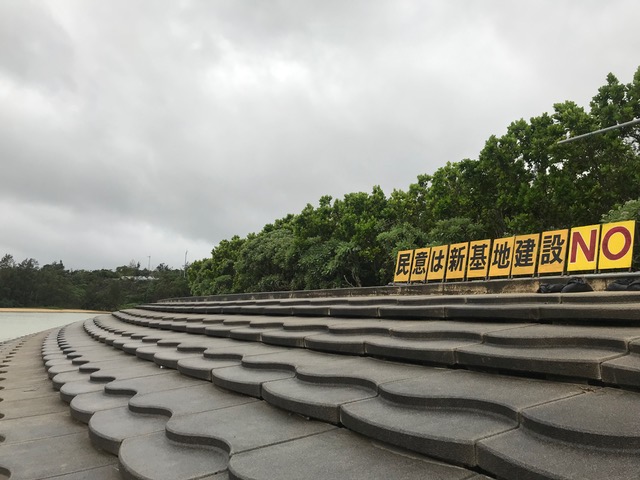
Base relocation has brought decades of military development into the spotlight, calling attention to the ways in which American infrastructure has been insinuated into foreign soil—where insinuation is not a euphemism. It describes a pattern of development that obscures violent material processes in the service of a larger narrative. The construction of military infrastructure does not draw wide media attention. Nor is it supposed to. Insinuation describes the covert optics of militarization at the global scale. The precarious position of American military bases in Okinawa—their vulnerability to natural forces, and the questionable extent of their strategic value—makes it clear that these are sites maintained for posturing, not protection. American bases in Okinawa are an archetypal performance in the theater of war.16
At the local scale, the process made evident by Red Flower by which this infrastructure is woven into the landscape is often both violent and performative, leading to novel forms of resistance and hybridity. Okinawan opposition to base relocation is chronicled in occupation literature or Facebook groups such as “I Oppose the Expansion of US Bases in Okinawa.”17 Photographs of the relocation site began to circulate across the island and social media sites before construction had even begun. Activists appropriated and created detailed diagrams of the landfill’s proposed program, compiled photographic evidence of the ecological crisis for online circulation, and exposed the material reality of military presence on the island. This documentation of the landfill disrupts the carefully constructed military narrative by making public the violent act.
In tandem with these images, Red Flower serves as a case study in what human rights scholar Thomas Keenan would call “counter-forensics”: a process of (re)claiming an authoritative narrative of people and place.18 For Keenan, the objectivity granted to the camera is a myth of photographic truth, elevating the image to testimony. Historically, the manipulation of photographic objectivity has allowed states to craft compelling narratives around statehood, occupation, or attitudes toward the landscape. As is the case in Okinawa, these narratives often produce instances of sanctioned violence that are quietly dismissed or strategically reframed. Counter-forensics describes the process by which research and associated images are used toward humanitarian or environmental ends by providing a new testimony. Coupled with historical testimonies like Mao Ishikawa’s, this understanding of images’ power creates a compelling view of the island that embraces the counter-forensic paradigm to resist dominant narratives espoused by colonial actors.
Red Flower spans many years. Eventually, viewers are introduced to these couples’ children, children who are not caught in, but inhabiting, two realities—the embodiment of a new politics for Okinawa. In 2018, Denny Tamaki was elected mayor of Okinawa. He is the island’s first mixed-race mayor, the son of a US Marine and an Okinawan mother. His campaign promise was to oppose the expansion and relocation of American Military bases. Embedded in the delicate images of these children playing on the beaches of Okinawa is an embrace of colonization’s hybrid cultures as that which can unravel nativist narratives of place and belonging. While Tamaki continues to face great obstacles, his election represented a step toward Okinawan sovereignty rooted in the island’s complex past. Today, the base relocation project remains in limbo: delayed by protests and Tamaki’s efforts but fervently pursued by the Japanese and American governments.
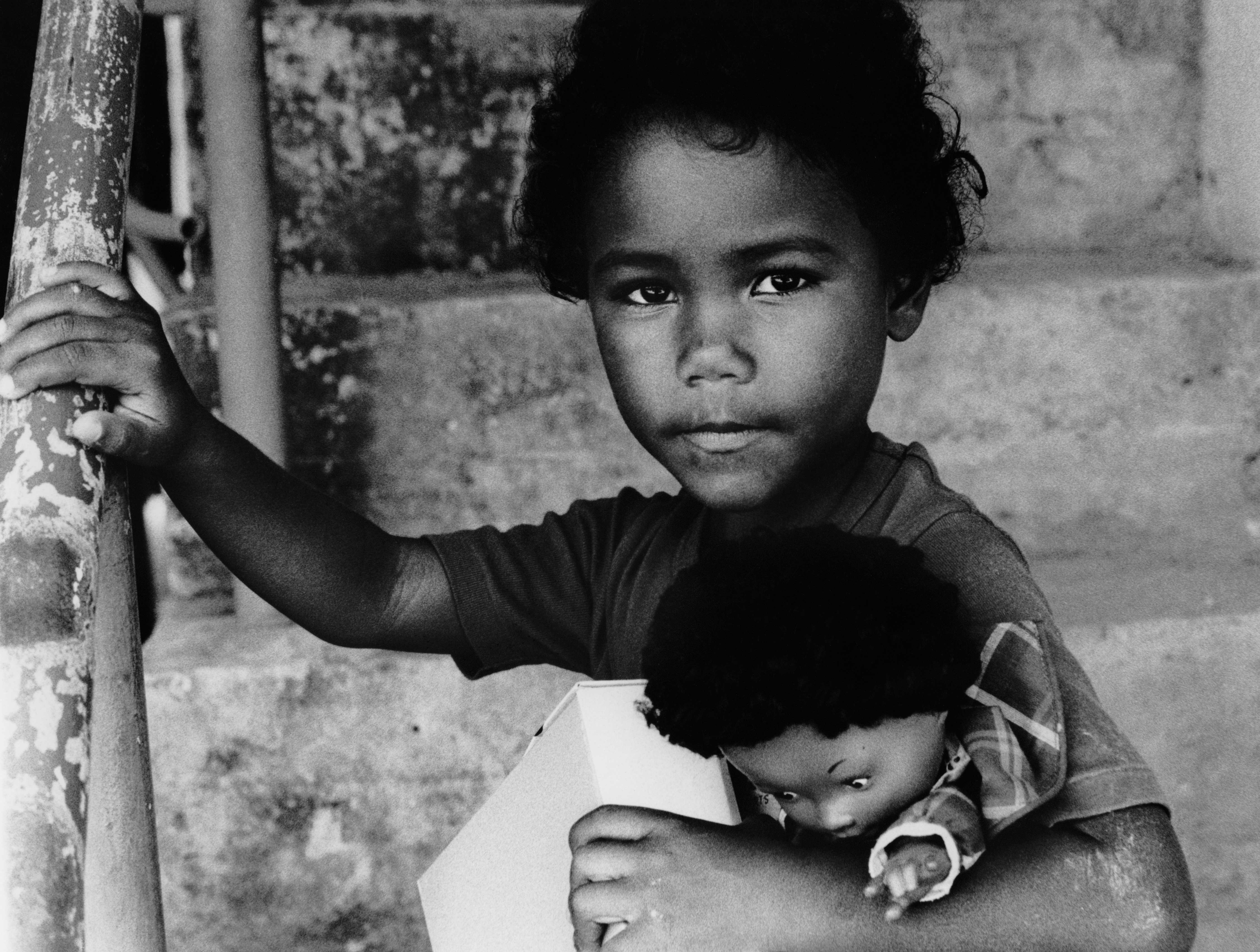
Resistance has become a fundamental part of the lived experience for generations of Okinawans. The Okinawan scholar Miyume Tanji argues that the everyday experience of Okinawans together with the revival and reinterpretation of traditional practices can operate as a kind of resistance. She writes, “in engaging and re-engaging with traumatic historical events that shaped all facets of contemporary Okinawa—amongst others, assimilation to Japan, war and massacre, and the US military occupation—transformative power is created.”19 Tanji provides a historical and cultural lens that engages the lived realities of colonization side-by-side with the island’s past. She embraces hybridity.
With this disposition in mind, Ayano Ginoza’s description of Okinawa as a fluid landscape composed of manicured lawns, steakhouses, peace memorials, and heritage sites where boundaries are delineated by barbed wire fences and racial lines gains new meaning. In the midst of this landscape, Ginoza locates Okinawan women in a hyper-sexualized, liminal space between empires. By foregrounding Okinawan women in their analysis of the landscape, Ginoza and Tanji begin to deconstruct binaries defining the built and the natural, the human and the nonhuman, and the local and the global in Okinawa. For Ginoza, Tanji, and Ishikawa, resistance occurs in the process of critical identity formation that resists banal colonizer-colonized discourse. Reading Red Flower into the present day begins to reveal what an embrace of the realities of entanglement and disentanglement that colonization produces might look like.
Such a complex portrait of Okinawan resistance can serve as a framework for approaching spatial realities in communities across the world affected by the presence of American military infrastructure. Understanding Red Flower in a spatial context also allows readers to draw broader connections between global forces of exchange and displacement. Using ethnographic and artistic accounts of such phenomena as a point of entry allows readers to keep the nuanced subjectivities of individuals affected by global systems in sight. This framework is unruly, but it begins to chart a new path forward for the spatial politics of Okinawa—one that itself begins with the reappropriation of vast swaths of occupied land toward a spatial program determined by the island’s inhabitants and ecological context.
Ishikawa’s Okinawa is exceptional, but unlike the narratives proffered for environments of consumption, it is a place of belonging. The most surprising images in Red Flower depict a deeply joyful life on the now-polluted beaches of Okinawa. Despite the general struggle and suffering evoked in contemporary discourse and historical narratives of this place, at the heart of each image is the embrace of joyful encounters. Mao Ishikawa’s friends laugh. They dress up. They make love.
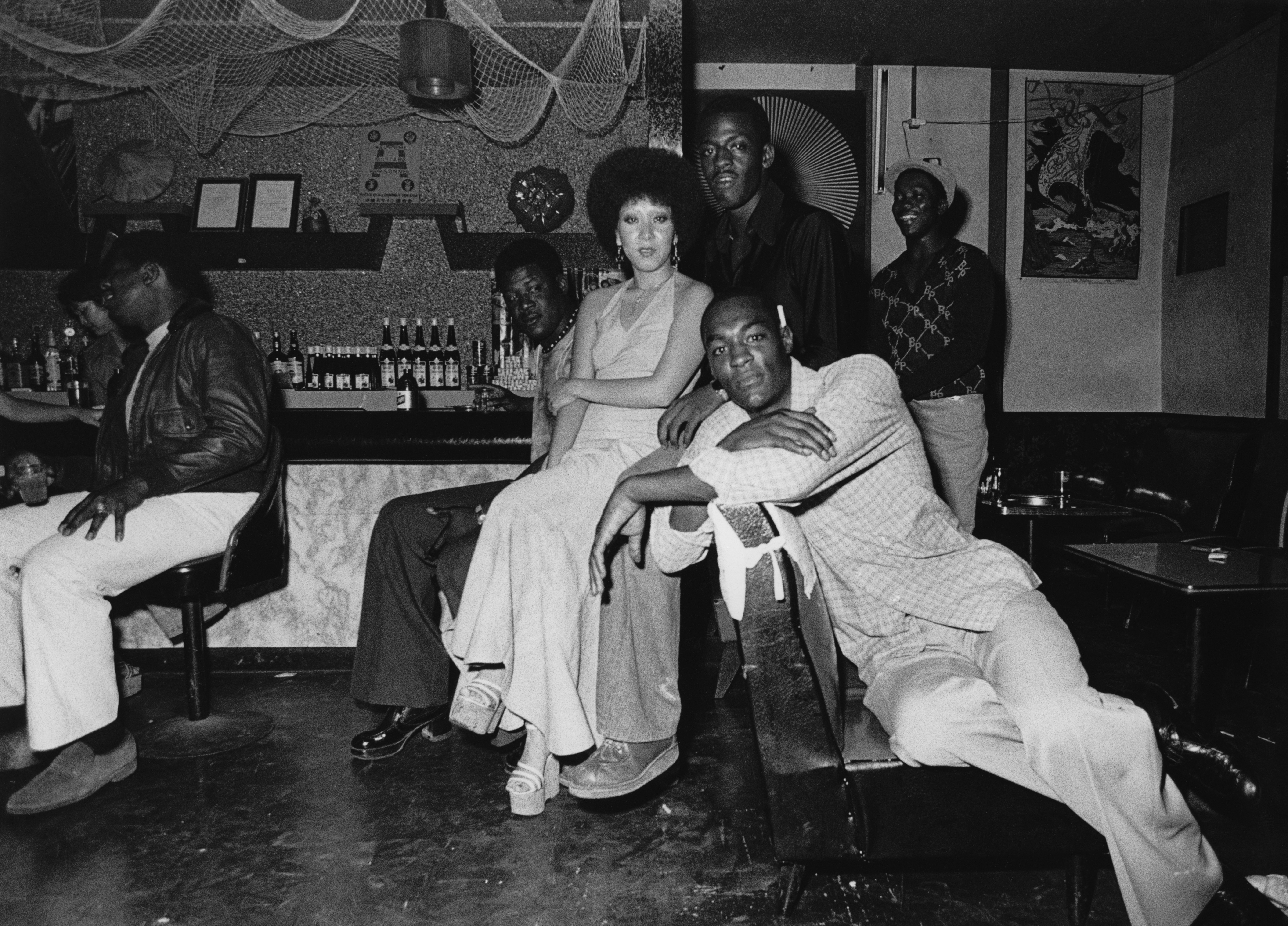
There is only one self-portrait in the book—a glamorous shot of the photographer seated at a chair surrounded by GI’s at a bar in Koza City. The photograph makes her unique subject position as an insider-outsider clear. A vantage point that stands in stark contrast to the military land survey or the generic image of the beach. This testimony fills in the blanks of detached aerial analysis by making a powerful contribution to the stories accessible to the public eye. Herein lies the value and beauty of Red Flower: it is a perspective from eye level. At the book's core is a reevaluation of the position from which one looks. To step out of the world of Mao Ishikawa and into the present is to look at these layered backdrops with the care they deserve. She asks readers to put their feet (with boots off) on the ground and embrace various, sometimes contradictory, truths. Red Flower is a testimony to the enclosed yet vulnerable architecture of daily life.
-
Mao Ishikawa, Red Flower (New York: Session Press, 2011). ↩
-
Ishikawa, Red Flower. ↩
-
Sasha Davis, “Seeing Like an Empire: Islands as Wastelands,” in The Empires’ Edge: Militarization, Resistance, and Transcending Hegemony in the Pacific (Athens: University of Georgia Press, 2015), 52–69. ↩
-
Davis, “Seeing Like an Empire,” 52–69. ↩
-
Many of these photographs were originally published in Ishikawa’s earlier collection Hot Days in Camp Hansen (Aaman Shuppan: Okinawa 1982). ↩
-
Andrew Pollack, “One Pleads Guilty to Okinawa Rape; 2 Others Admit Role,” The New York Times, November 8, 1995. ↩
-
Robert Eldrigts, “The 1995 Okinawa Rape that Shook US–Japan Ties,” The Japan Times, September 4, 2020, link. The technical title for the SOFA agreement is “Agreement under Article VI of the Treaty of Mutual Cooperation and Security between Japan and the United States of America, Regarding Facilities and Areas and the Status of United States Armed Forces in Japan.” ↩
-
Eldrigts, “The 1995 Okinawa Rape that Shook US–Japan Ties,” link. ↩
-
Linda Isako Angst, “The Sacrifice of a Schoolgirl: The 1995 Rape Case, Discourses of Power, and Women’s Lives in Okinawa,” Critical Asian Studies 33 (2001): 2, 243–266. ↩
-
Ayano Ginoza, “R&R at the Intersection of US and Japanese Dual Empire: Okinawan Women and Decolonizing Militarized Heterosexuality,” American Quarterly 68, no. 3 (2016): 589, 583–591. ↩
-
An Indigenous sea mammal that is a cousin of the manatee. ↩
-
Steve Rabson, “Okinawa’s Henoko was a ‘Storage Location’ for Nuclear Weapons,” The Asia-Pacific Journal 11, issue 1, no. 6 (2013), link. ↩
-
Gavan McCormack and Hideki Yoshikawa, “US Military Base Construction at Henoko-Oura Bay and the Okinawan Governor’s Strategy to Stop It,” The Asian-Pacific Journal: Japan Focus 16, issue 2, no. 1 (2018), link. ↩
-
McCormack and Yoshikawa, “US Military Base Construction.” ↩
-
Anna Fifield, “In Okinawa, Protesters Dig in as Work Proceeds to Relocate US Marine Base,” The Washington Post, February 7, 2016, link. ↩
-
Sasha Davis, “The US military base network and contemporary colonialism: Power projection, resistance and the quest for operational unilateralism,” Political Geography 30 (2011): 215–224. ↩
-
From the group page: “The Network for Okinawa (2010–12) drew together reps from peace, environmental & faith-based NGOs, academia, & think tanks. It supported the closure of the US Marine base at Futenma and opposed the construction of other US bases in Okinawa,” link. ↩
-
Thomas Keenan, “Counter-Forensics and Photography,” Grey Room 55 (Spring 2014): 58–77. ↩
-
Miyume Tanji, “Rethinking Resistance in Everyday Okinawa: Diaspora, Transformation and Minor Literature,” Asian Studies Review (2012), 112. ↩
David Hurtado is an artist, designer, and researcher interested in the flow of images and their impact on built and natural environments. He is currently a strategist at 2x4 in New York City and holds a B.A. in Architecture and Urbanism from Yale University.

